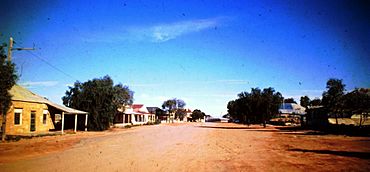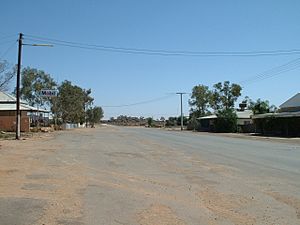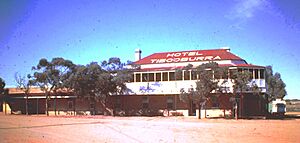Tibooburra facts for kids
Quick facts for kids TibooburraNew South Wales |
|||||||||||||||
|---|---|---|---|---|---|---|---|---|---|---|---|---|---|---|---|

Main street of Tibooburra looking towards the two storey hotel
|
|||||||||||||||

Tibooburra main street in 1976
|
|||||||||||||||
| Population | 134 (2016 census) | ||||||||||||||
| Postcode(s) | 2880 | ||||||||||||||
| Elevation | 183 m (600 ft) | ||||||||||||||
| Location |
|
||||||||||||||
| LGA(s) | Unincorporated Far West Region | ||||||||||||||
| County | Poole | ||||||||||||||
| State electorate(s) | Barwon | ||||||||||||||
| Federal Division(s) | Parkes | ||||||||||||||
|
|||||||||||||||
|
|||||||||||||||

Tibooburra is a small town in the very northwest of New South Wales, Australia. It is about 1187 kilometers (738 miles) from Sydney, the state capital.
Many tourists visit Tibooburra on their way to Sturt National Park. They also pass through when traveling to or from Innamincka in South Australia or Birdsville in Queensland. In 2016, Tibooburra had a population of 134 people.
Tibooburra has limited services, but you can find fuel, food, and places to stay. For bigger needs like medical care or shopping, people usually go to Broken Hill.
The New South Wales National Parks and Wildlife Service has a visitor center in town. There is also a police station. An airstrip is located about 6 kilometers (3.7 miles) east of the town. The road from Broken Hill was fully paved in 2020, making travel much easier.
Contents
Exploring Tibooburra's Past
First Peoples of Tibooburra
Tibooburra is on the traditional lands of the Wangkumarra Aboriginal people. They have lived here for thousands of years.
Early European Journeys
The first European group to explore this area was led by Charles Sturt in 1844. He was stuck for six months by a drought at a place called Depot Glen, south of Tibooburra. He then tried to go northwest but couldn't cross the desert.
Later, in 1861, Burke and Wills traveled through this area. They were on their way north towards the Gulf of Carpentaria. The search for Burke and Wills helped open up the land for farming and raising animals.
The Gold Rush Era
After gold was found near Milparinka, more gold was discovered around Tibooburra in 1880. At first, this area was called The Granites. In 1881, a town was planned and named Tibooburra by W.H.J. Slee. He chose an Aboriginal name for the town, which means "heap of boulders."
In 1887, Slee reported that 19 gold machines were working. About 250 people lived in and around Tibooburra. People even said that gold could be found on the streets after heavy rain!
Tibooburra in the 20th Century
By 1900, gold mining slowed down. Raising sheep became the main activity in Tibooburra. Large sheep farms were important for the town's social and business life until the 1980s.
For a long time, Tibooburra was hard to reach because of rough, unpaved roads. But with more people using 4WD vehicles and new paved roads, it became easier for tourists to visit.
In more recent times, artists and musicians, like Clifton Pugh, became interested in this remote area. Pugh often stayed at the Family Hotel (which opened in 1882). He painted many pictures and drawings on an inside wall of the hotel.
Things to See and Do
Tibooburra is known for its amazing granite rock formations. These rocks pop up right next to, and even within, the town's streets. You can also see old buildings that show what life was like in the early days.
Nearby is Sturt National Park. This park includes Cameron Corner, where the borders of three states meet: Queensland, South Australia, and New South Wales. The famous dog fence along the borders is also a popular sight.
The Family Hotel and the larger Tibooburra Hotel (also called the Two Storey Hotel) are great places for visitors to stop for a drink. There is also a drive-in theatre on the main street.
Learning at Tibooburra Outback School of the Air
Tibooburra Outback School of the Air provides education for local children. It also teaches children who live on properties in the surrounding area. The school started as a Distance Education Centre in 1991. Before that, children in town went to a local school, and those on farms learned from schools in bigger towns like Broken Hill.
The school itself was first established in 1886. There are no high school facilities in Tibooburra. Older children either travel 365 kilometers (227 miles) to the nearest high school, learn at home, or go to boarding schools.
Once a term, students from the remote properties come to a 'mini-school' at the main school. These mini-schools often have fun themes, like pirates or the circus. They include many enjoyable and educational activities. Families living out of town also get two home visits each year. During these visits, a teacher and students spend the day on their property.
In 2004, the school changed from using radio for lessons to the Satellite Education Program. This made learning even better for students.
Tibooburra's Weather
Tibooburra has a hot desert climate (BWh). Temperatures often go above 40°C (104°F) in summer. Winters are milder, with daytime temperatures around 19°C (66°F). However, it often freezes at night.
Rainfall is low throughout the year, except for occasional thunderstorms. In March 1949 and January 1974, the town received about 390 mm (15 inches) of rain. This was almost twice its average yearly rainfall! In its driest year, 1919, only 47.9 mm (1.8 inches) of rain fell.
| Climate data for Tibooburra | |||||||||||||
|---|---|---|---|---|---|---|---|---|---|---|---|---|---|
| Month | Jan | Feb | Mar | Apr | May | Jun | Jul | Aug | Sep | Oct | Nov | Dec | Year |
| Record high °C (°F) | 47.9 (118.2) |
46.5 (115.7) |
45.0 (113.0) |
38.3 (100.9) |
34.4 (93.9) |
28.9 (84.0) |
31.7 (89.1) |
34.1 (93.4) |
39.3 (102.7) |
42.4 (108.3) |
46.4 (115.5) |
46.7 (116.1) |
47.9 (118.2) |
| Mean daily maximum °C (°F) | 36.2 (97.2) |
35.2 (95.4) |
32.1 (89.8) |
27.0 (80.6) |
21.9 (71.4) |
18.4 (65.1) |
17.8 (64.0) |
20.4 (68.7) |
24.6 (76.3) |
28.5 (83.3) |
32.1 (89.8) |
34.9 (94.8) |
27.4 (81.3) |
| Mean daily minimum °C (°F) | 22.1 (71.8) |
21.7 (71.1) |
18.6 (65.5) |
13.9 (57.0) |
9.4 (48.9) |
6.4 (43.5) |
5.4 (41.7) |
6.9 (44.4) |
10.3 (50.5) |
14.1 (57.4) |
17.6 (63.7) |
20.4 (68.7) |
13.9 (57.0) |
| Record low °C (°F) | 5.6 (42.1) |
8.9 (48.0) |
5.6 (42.1) |
1.7 (35.1) |
−1.1 (30.0) |
−2.5 (27.5) |
−2.3 (27.9) |
−0.6 (30.9) |
0.0 (32.0) |
−1.0 (30.2) |
3.9 (39.0) |
5.6 (42.1) |
−2.5 (27.5) |
| Average precipitation mm (inches) | 28.0 (1.10) |
29.8 (1.17) |
24.8 (0.98) |
14.5 (0.57) |
18.0 (0.71) |
16.5 (0.65) |
16.6 (0.65) |
11.6 (0.46) |
12.4 (0.49) |
18.4 (0.72) |
18.0 (0.71) |
22.1 (0.87) |
230.5 (9.07) |
Images for kids






